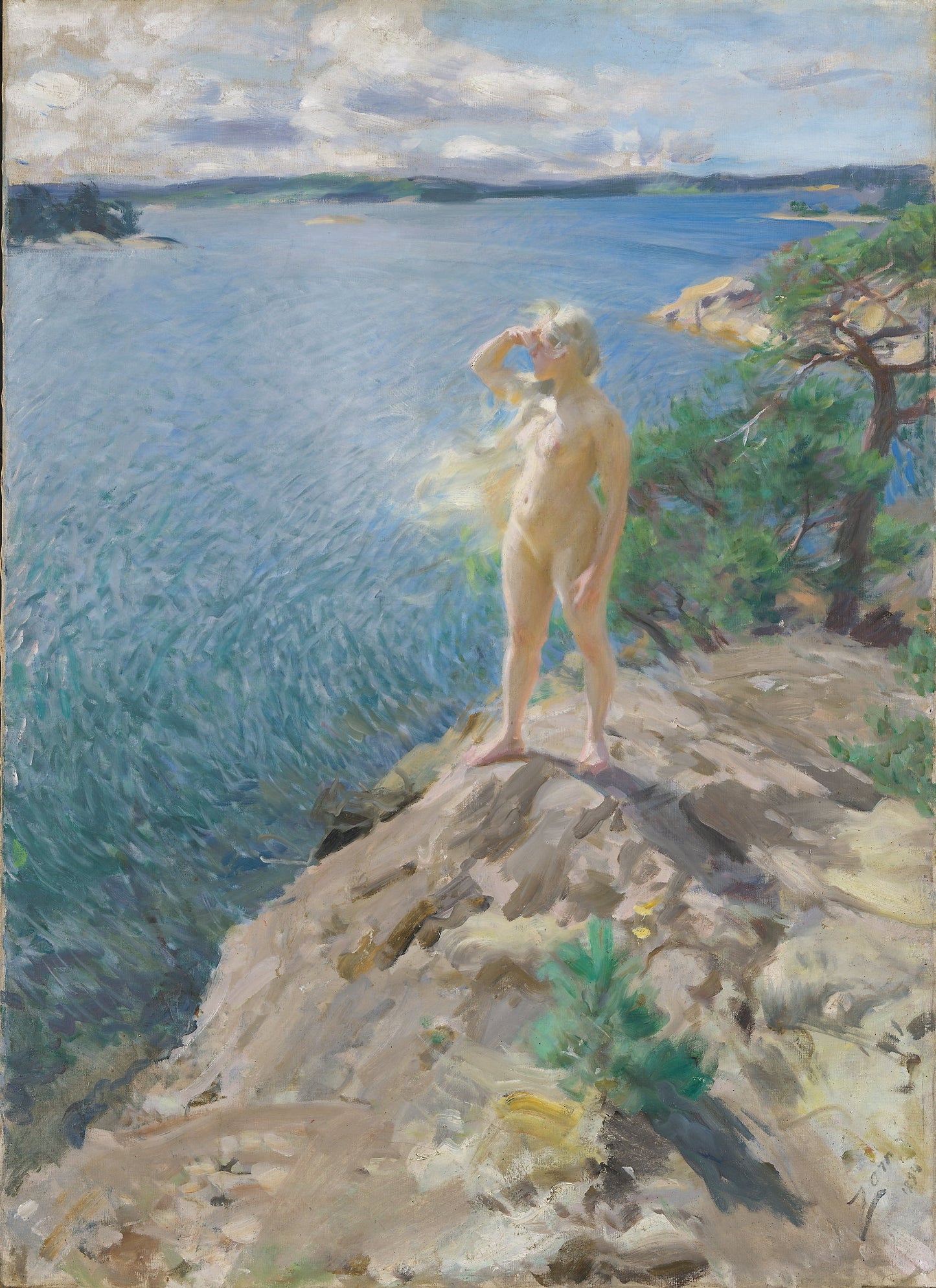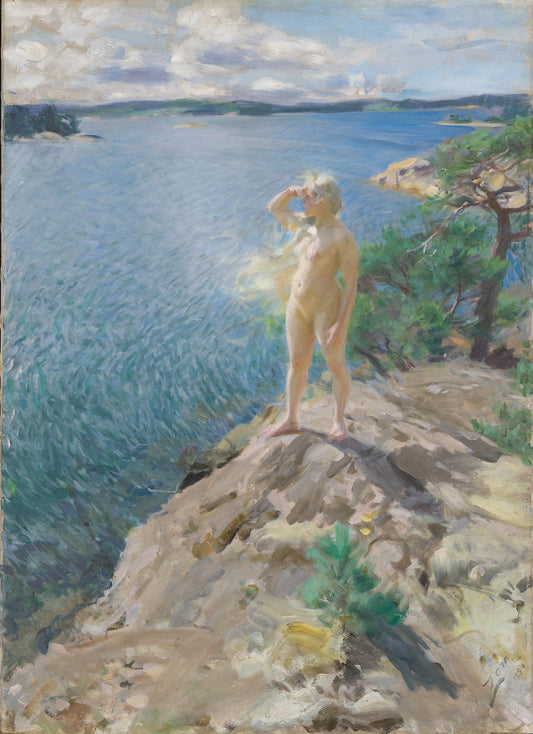Anders Zorn
In the archipelago
In the archipelago
Couldn't load pickup availability
High-quality reproductions with authentic colors and details from DAIDDA's exclusive collaboration with the National Museum. Posters are printed on 230g Litho White Matt photo paper with white border and logo. Artprints are printed on 260g Museum Natural Rag 100% cotton paper without white border and logo. Produced to order in our own print lab.
About the original:
A fresh, warm summer wind seems to blow through the picture. So immediately and spontaneously, Anders Zorn is able to capture the play of light against skin, water and stone with broad, fast brushstrokes.
On a cliff high above the water stands a naked woman. Zorn does not portray her in a typical nude pose, but completely unabashed and natural. Without shame, she lets her naked body be warmed by the strong sun, while her gaze gazes into the distance. Due to the high point from which the figure is viewed, it is almost completely framed by the surface of the water, and the sparkling wave structure of the water seems to lie concentrically around the woman's body. This harmonious unity between body and landscape nevertheless breaks with the shameless female ideal of the time.
Towards the end of the 1880s, Zorn and other Scandinavian artists traveled far from the big cities they came from, to places where life was lived in harmony with nature. Zorn found his favorite spot on the island of Dalarö at the far end of the Stockholm archipelago, where from 1888 onwards he painted a series of pictures of people bathing. The result was paintings full of light and summer. He often prepared these paintings with photographs, sketches and watercolours.
Although the picture's Swedish title, Sea Nymph, and the woman's conspicuously long hair allude to a mythical figure, Zorn here creates an independent Nordic-Impressionist response to the Arcadian bathing scenes we find in Cézanne, Renoir and several other painters. In his time, Zorn was the foremost impressionist among the Scandinavian artists.
Text: Nils Ohlsen
Date: 1894
Other titles: Sea Nymph (SWE)
In the Skerries (ENG)
Designation: Painting
Material and technique: Oil on canvas
Technique: Oil
Material: Canvas
Dimensions: 125.7 x 91 cm
Subject: Visual arts
Classification: 532 - Visual arts
Type of motif: Nude Landscape
Acquisition: Purchased 1895
Inventory no.: NG.M.00462
Part of exhibition: The dance of life. The collection from antiquity to 1950, 2011 - 2019
Reason and feelings. Nordic painting and sculpture from the collections, 2009
Registration level: Single object
Owner and collection: The National Museum of Art, Architecture and Design, Visual Art Collections
Photo: Børre Høstland/Larsen, Frode
Shipping and returns
Shipping and returns
Shipping: We deliver to Scandinavia, the EU, the USA and several other countries. Please contact us if your country is not listed and we will try to arrange delivery.
Delivery time: 2-5 days within Norway, 7 days in Europe, 14 days globally.
Packaging: Our products are made to order and sent rolled in environmentally friendly packaging.
Customs Fees: International orders may be subject to customs fees, which are not included in shipping costs.
Return policy: You can return images within 14 days. See our returns page for more information.
Secure Payment: We never store your payment details. See our privacy policy for details.

See all works
-
In the archipelago
Vendor:Anders ZornRegular price From 150,00 NOKRegular priceUnit price per

Anders Zorn
Anders Zorn was a Swedish artist who worked as a painter, graphic artist and sculptor. He first wanted to become a sculptor, but quickly switched to watercolor painting when he studied at the Art Academy in Stockholm between 1875 and 1881. On trips to more southern regions in the 1880s, he created a series of watercolors that were filled with light and valor (Sigøynersmie in 1885 and In the harbor of Algiers in 1887). He also painted many subjects from his homeland, sometimes with realistic details (Our Daily Bread in 1886) and other times with a focus on light effects and reflections (Bølgeskvulp in 1887).
In 1887 he started painting with oil colours. Zorn's strong attachment to his hometown and his interest in popular cultural values are expressed in paintings such as Church Procession in Mora and Bread Baking from 1889, and especially Midsummer Dance from 1897, which is painted with a broad, impressionistic brush. A summer stay at Dalarö in Stockholm's archipelago in 1887 introduced him to his most popular subject circle, blonde, luminous female nudes against a background of fresh grass, sparkling sea and red and gray crags (Summer in 1887, Une première and Ute in 1888, In the archipelago (National Museum) and Frileuse in 1894). Zorn was also a skilled portrait painter with the ability to capture characteristic situations or movements (Coquelin Cadet in 1889 and En skål i Idun in 1892), and he soon gained international fame and was showered with commissions. He had many admirers in the United States, including Isabella Stewart Gardner whom he portrayed in 1894.
Zorn's etchings, which often took up motifs from his paintings, are technically outstanding, and among his sculptures Nymfe og faun (1895) perhaps stands first. In Mora stands his statue of Gustav Vasa (1903), and in front of the Art Academy in Stockholm is his fountain figure Morgenbad (1907). Zorn's burning interest in his home town and cultural heritage is expressed through his extensive collecting activities, which form the basis of the Zorn Museum in Mora (opened in 1939). He was also a mesén and, among other things, established a community college in Mora in 1907. His autobiographical notes were published in 1982.




